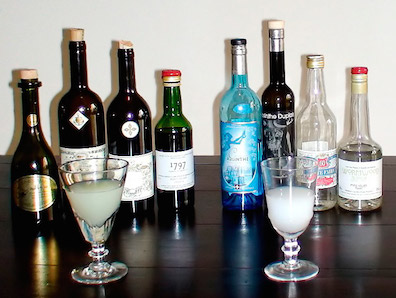For much of the 20th century absinthe had a reputation for
mind-altering and mind-damaging properties, and many countries
banned its sale soon after the time represented in Ulysses.
(France joined the bandwagon in 1914, but the United Kingdom
never outlawed the drink, probably because not many people
consumed it on the islands.) Most of the charges against
absinthe were ridiculously exaggerated, exploited by campaigns
of demonization similar to the "reefer madness" campaign that
succeeded in outlawing marijuana in the United States. The "wormwood"
in the liquor (leaves and flowers of the grand wormwood plant,
Artemisia absinthium) has never been shown to be
hallucinogenic, addictive, or poisonous, and it may have
medicinal properties. Nevertheless, many people at the turn of
the 20th century believed that absinthe had powerful effects
beyond those of the high alcohol content.
Some absinthes are greenish, because of the presence of
botanicals and/or artificial coloring. Others are clear. When
mixed with water, botanical essences come out of alcoholic
solution to produce a cloudy look called the louche,
freeing up some of the herbal flavors in the spirit. Fin
de siècle French bars usually served absinthe in this
way, dripping water over a sugar cube and into a glass until
the alcohol was considerably diluted.
The opalescence probably gave rise to the nickname that
absinthe enjoyed in Joyce's time: la fée verte, the
green fairy. "Sipping his green fairy as Patrice his
white" may imply that Kevin's son drinks the white
louche absinthe shown in the photograph
(grammatically, "white" must modify "fairy"), or perhaps, as
Gifford infers, the reference is to Patrice's lait chaud mentioned
earlier in Proteus (with "as" meaning "in the same
manner as"). Later in the paragraph about Kevin Egan Stephen
thinks, "His breath hangs over our saucestained plates, the
green fairy's fang thrusting between his lips."
Yet once more in this paragraph of Proteus,
absinthe makes an appearance as someone says or thinks, "Green
eyes, I see you. Fang, I feel," apparently
connecting the treacherous green fairy to "the green-eyed
monster," Iago's description of jealousy in Shakespeare's Othello.
Egan has been talking before these two sentences, but his
speech concerns young women giving massages to lascivious men.
It would be very strange for him to interrupt these thoughts
to apostrophize absinthe. Furthermore, it was Stephen who
contemplated the fairy's fang thrusting between Egan's lips
earlier in the paragraph, and only Stephen has the literary
proclivities to connect the green fairy of Paris to Iago's
monster. So it seems reasonable to assume that Stephen's
internal monologue here breaks into Egan's spoken dialogue.
The Shakespearean allusion will return in Circe.
It is probably not an artistic accident that, when the young
men leave the maternity hospital for Burke's pub at the end of
Oxen of the Sun, just before the hallucinogenic
extravagances of Circe, Stephen chooses this drink
for his final alcoholic indulgence. After offering to treat
everyone to drinks ("Query. Who's astanding this here do?
Proud possessor of damnall"), and asking what the others want,
he declares his own preference: "Absinthe for me,
savvy?" On the second round, all the others join
him: "Landlord, landlord, have you good wine, staboo? Hoots,
mon, a wee drap to pree. Cut and come again. Right. Boniface!
Absinthe the lot. Nos omnes biberimus viridum
toxicum diabolus capiat posterioria nostria."
Stephen's Latin means, "We will all drink green poison. May
the devil take the hindmost."
In Circe, Bloom tries to mollify the soldiers by
explaining why Stephen is talking so wildly: "He doesn't know
what he's saying. Taken a little more than is good for him. Absinthe.
Greeneyed monster."


